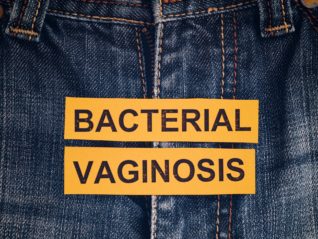
Angela Kelly, MA and Michael Stanclift, ND
This is part two in a three-part series about bacterial vaginosis (BV). In part one we discussed a healthy vaginal microbiome, BV’s characteristics, and diagnostic criteria. In this section, we’ll explore risk factors for developing BV, the health impacts of it, and current conventional therapies.
BV risk factors
While the precise causes of BV are still being investigated, researchers have discovered the following risk factors that can contribute to its development:
- Having a sexual partner with a history of BV1
- Douching2-3
- Smoking4-5
- Recent antibiotic use5-6
- Being a Black or Mexican-American woman1,3,7-9
- Menstruation2,5,10-11
- Pregnancy5,12
- Having an IUD (especially copper)13
- New sexual partner(s)—result in a 2.5-fold increased risk1,4
- Uncircumcised sexual partner(s)4,14
- Inconsistent condom use4
- Previous STI diagnosis15-16Having female sexual partners or both female and male sexual partners1,4,17
- Becoming sexually active at 14 years of age or younger18
- Socioeconomic status5,19
- Chronic stress20-21
- Obesity22
Health impact of BV
Although most cases of BV are asymptomatic, BV can still have devastating health consequences. Even without symptoms, BV can cause:
- Genital inflammation23
- Increased risk of contracting and passing STIs, including a 60% increase in the acquisition of HIV23-30
- Impaired healing of the epithelial barrier11,31
- Increased risk of HPV infection and resulting cervical cancer11,32
- Infertility33-35
- Increased risk of pelvic inflammatory disease (PID)36-38
- Failure of in vitro fertilization39
- Miscarriage12,39,40
- Amniotic fluid infection41
- Preterm birth42-44,45-46
- Postsurgical infections47
Beyond the raised physical health risks, BV is associated with a significant negative impact on self-esteem, sexual relationships, and quality of life.48 Women report feelings of shame, stress, anxiety over loss of control over recurrent infections, and fear of others’ detection of odor or discharge. With approximately 29% of women in the US suffering from BV, more effective and lasting treatments are needed to reduce the health and economic burden of bacterial vaginosis.22
Current antimicrobial therapeutics and resistance
Current antimicrobial therapeutics often provide only temporary relief and ultimately contribute to antibiotic resistance. BV is usually treated with metronidazole, clindamycin, or a combination of oral and intravaginal antibiotic therapies.49Occasionally other antibiotics such as rifaximin, secnidazole, and tinidazole are prescribed.49-51 A 2020 in vitro study showed clindamycin had greater initial effectiveness against G. vaginalis than metronidazole; however, clindamycin is strongly associated with antibiotic resistance.52-53 In a randomized clinical trial 17% of cases had baseline clindamycin resistance, and 53% showed resistance to it after therapy.53 Also of consideration, clindamycin has been linked to Clostridioides difficile (C. diff) colonization and pseudomembranous colitis.13,50,54 Studies demonstrate G. vaginalis and A. vaginae also show resistance to metronidazole, although to a lesser extent than clindamycin.52,55 When metronidazole is used to treat BV, it can break up the biofilm created by G. vaginalis and A. Vaginae; however, live cells can persist within the biofilm, allowing for recurrences.56 Microbial profiling shows metronidazole temporarily reduces vaginal microbial diversity, and the reestablished microbiota rarely returns to a balanced lactobacilli-dominant state.57 Treatment with metronidazole frequently causes the adverse effects of nausea, vomiting, GI disturbances, and metallic taste.54,58 Occasionally metronidazole may also cause seizures, peripheral neuropathy, transient neutropenia, and allergic reactions, including anaphylaxis.58
These findings highlight that effective and lasting treatments for BV are urgently needed. The pipeline of antibiotics continues to dwindle, and bacteria grow more resistant with the antibiotic treatment of each episode.59 The treatment of protracted or recurring cases of BV often results in a revolving door of relapses for patients.59 Identifying lasting treatments for BV that rely less on antibiotics is of the utmost urgency.60,61
BV recurrence after antimicrobials
The recurrence rate following treatment of BV with antibiotics is high, with a study revealing that 58% of participants experienced a recurrence within a year and 69% returned to abnormal vaginal profiles.50,58 The high rate of recurrence appears to be multifaceted, linked to biofilms created by G. vaginalis and A. vaginae, impaired immune system response, antibiotic resistance, hygiene practices, and, according to some researchers, sexual transmission and reinfection by a woman’s sexual partner(s).60-63 Although there are variations in studies, a recent study showed improved BV recurrence rates when male partners were treated with oral and topical antibiotics. More research on the efficacy of treating sexual partners is needed.64 Having an untreated sexual partner is linked to a raised risk of recurrence of BV, although more research is needed.63,65
We can see the contributing factors for BV are multifactorial and that simple antimicrobial therapies are failing the majority of women they are prescribed to help. In our next and final installment in this series we’ll explore alternative and emerging treatments for BV, including the role of probiotics. We’ll see how a problem characterized by microbial overgrowth may ultimately need more microbes to see its resolution.
Citations
- Plummer EL et al. Combined oral and topical antimicrobial therapy for male partners of women with bacterial vaginosis: acceptability, tolerability and impact on the genital microbiota of couples – a pilot study. PLoS One. 2018;13(1):e
- Borges S et al. The role of lactobacilli and probiotics in maintaining vaginal health. Arch Gynecol Obstet. 2014;289:479-489.
- Ness S et al. Can known risk factors explain racial differences in the occurrence of bacterial vaginosis? J Natl Med Assoc. 2003;95:201-212.
- Bradshaw CS et al. High recurrence rates of bacterial vaginosis over the course of 12 months after oral metronidazole therapy and factors associated with recurrence. J Infect Dis. 2006;193:1478–1489.
- Amabebe E et al. Mechanistic insights into immune suppression and evasion in bacterial vaginosis. Curr microbiol. 2022;79(3):84.
- Wilks M et al. Identification and H(2)O(2) production of vaginal lactobacilli from pregnant women at high risk of preterm birth and relation with outcome. J Clin Microbiol. 2004;42(2):713-717.
- Peebles K et al. High global burden and costs of bacterial vaginosis: a systematic review and meta-analysis. Sex Transm Dis. 2019;46(5):304-311.
- https://www.cdc.gov/std/bv/stats.htm. Accessed September 19, 2022.
- Hensel KJ et al. Pregnancy-specific association of vitamin D deficiency and bacterial vaginosis. Am J Obstet Gynecol. 2011;204(1):e1-41.e419.
- Reid G et al. Use of Lactobacillus rhamnosus GR-1 and fermentum RC-14 significantly alters vaginal flora: randomized, placebo-controlled trial in 64 healthy women. FEMS Immunol Med Microbiol. 2003;35:131–134.
- Coudray MS et al. Bacterial vaginosis-a brief synopsis of the literature. Eur J Obstet Gynecol Reprod Biol. 2020;245:143-148.
- Nelson DB et al. Bacterial vaginosis in pregnancy: current findings and future directions. Epidemiol Rev. 2002;24(2):102-108.
- Joseph RJ et al. Finding a balance in the vaginal microbiome: how do we treat and prevent the occurrence of bacterial vaginosis?. Antibiotics (Basel). 2021;10(6):719.
- Plummer EL et al. Lactic acid-containing products for bacterial vaginosis and their impact on the vaginal microbiota: A systematic review. PloS One. 2021;16(2):e0246953-e0246953.
- Nelson DB et al. Bacterial vaginosis in pregnancy: current findings and future directions. Epidemiol Rev. 2002;24(2):102-108.
- Moi H. Prevalence of bacterial vaginosis and its association with genital infections, inflammation and contraceptive methods in women attending sexually transmitted disease and primary health clinics. Int J STD AIDS. 1990;1:86–94.
- Marrazzo JM et al. Safety and efficacy of a novel vaginal anti-infective, TOL-463, in the treatment of bacterial vaginosis and vulvovaginal candidiasis: a randomized, single-blind, phase 2, controlled trial. Clin Infect Dis. 2019;68(5):803-809.
- Hensel KJ et al. Pregnancy-specific association of vitamin D deficiency and bacterial vaginosis. Am J Obstet Gynecol. 2011;204(1):e1-41.e419.
- Allsworth JE et al. Severity of bacterial vaginosis and the risk of sexually transmitted infection. Am J Obstet Gynecol. 2011;205(2):113.e1-113.e1136.
- Culhane JF et al. Maternal stress is associated with bacterial vaginosis in human pregnancy. Matern Child Health J. 2001;5(2):127-134.
- Amabebe E et al. The vaginal microenvironment: the physiologic role of lactobacilli. Front Med (Lausanne). 2018;5:181.
- Koumans EH et al. The prevalence of bacterial vaginosis in the United States, 2001-2004; associations with symptoms, sexual behaviors, and reproductive health. Sex Transm Dis. 2007;34(11):864-869.
- McKinnon et al. The evolving facets of bacterial vaginosis: implications for HIV transmission. AIDS Res Hum Retrovir. 2019;35(3):219-228.
- Cherpes et al. Association between acquisition of herpes simplex virus type 2 in women and bacterial vaginosis. Clin Infect Dis. 2003;37:319–325.
- Wiesenfeld et al. Bacterial vaginosis is a strong predictor of Neisseria gonorrhoeae and Chlamydia trachomatis infection. Clin Infect Dis. 2003;36:663–668.
- Dareng EO et al. Prevalent high-risk HPV infection and vaginal microbiota in Nigerian women. Epidemiol Infect. 2015:1–15.
- Atashili J et al. Bacterial vaginosis and HIV acquisition: a meta-analysis of published studies. 2008;22(12):1493–1501.
- Sharami SH et al. Urinary tract infections in pregnant women with bacterial vaginosis. J Obstet Gynaecol. 2007;27(3):252-254.
- Afrakhteh M et al. Relationship between bacterial vaginosis and urinary tract infection. J Zanjan Univ Med Sci H Serv. 2003;42:37–42.
- Harmanli OH et al. Urinary tract infections in women with bacterial vaginosis. Obstet Gynecol (NY 1953). 2000;95(5):710-712.
- Zevin AS et al. Microbiome composition and function drives wound-healing impairment in the female genital tract. PLoS Pathog. 2016;12(9):e1005889-e1005889.
- Suehiro TT et al. Association of human papillomavirus and bacterial vaginosis with increased risk of high-grade squamous intraepithelial cervical lesions. Int J Gynecol Cancer. 2019;29(2):242-249.
- Ravel J et al. Bacterial vaginosis and its association with infertility, endometritis, and pelvic inflammatory disease. Am J Obstet Gynecol. 2021;224(3):251-257.
- Damke E et al. Male partners of infertile couples with seminal positivity for markers of bacterial vaginosis have impaired fertility. Am J Mens Health. 2018;12(6):2104-2115.
- He Y et al. Evaluation of the inhibitory effects of Lactobacillus gasseri and Lactobacillus crispatus on the adhesion of seven common lower genital tract infection-causing pathogens to vaginal epithelial cells. Front Med (Lausanne). 2020;7:284.
- Wiesenfeld et al. Lower genital tract infection and endometritis: insight into subclinical pelvic inflammatory disease. Am J Obstet Gynecol. 2002;100(3):456-463.
- Soper DE et al. Observations concerning the microbial etiology of acute salpingitis. Am J Obstet Gynecol. 1994;170:1008–1014.
- Hillier SL et al. Role of bacterial vaginosis-associated microorganisms in endometritis. Am J Obstet Gynecol. 1996;175:435– 441.
- Moreno I et al. Evidence that the endometrial microbiota has an effect on implantation success or failure. Am J Obstet Gynecol. 2016;215(6):684-703.
- Ralph et al. Influence of bacterial vaginosis on conception and miscarriage in the first trimester: cohort study. BMJ. 1999;319:220-223.
- Silver HM et al. Evidence relating bacterial vaginosis to intraamniotic infection. Am J Obstet Gynecol. 1989;161:808–812.
- Kurki T et al. Bacterial vaginosis in early pregnancy and pregnancy outcome. Obstet Gynecol. 1992;80:173–177.
- Hillier SL et al. Association between bacterial vaginosis and preterm delivery of a low- birth-weight infant. N Engl J Med.1995;333:1737–1742.
- Gratocos E et al. Spontaneous recovery of bacterial vaginosis during pregnancy is not associated with an improved perinatal outcome. Acta Obstet Gynecol Scand. 1998;77:37–40.
- Meis PJ et al. The preterm prediction study: significance of vaginal infections. Am J Obstet Gynecol. 1995;173:1231–1235.
- Goldenberg RL et al. The preterm prediction study: fetal fibronectin, bacterial vaginosis, and peripartum infection. Obstet Gynecol. 1996;87:656–660.
- Persson E et al. Infections after hysterectomy. A prospective nation-wide Swedish study. The Study Group on Infectious Diseases in Obstetrics and Gynecology within the Swedish Society of Obstetrics and Gynecology. Acta Obstet Gynecol Scand. 1996;75(8):757-761.
- Bilardi J et al. Women’s management of recurrent bacterial vaginosis and experiences of clinical care: a qualitative study. PLoS One. 2016;11(3): e0151794.
- Muzny CA et al. The role of antimicrobial resistance in refractory and recurrent bacterial vaginosis and current recommendations for treatment. Antibiotics (Basel). 2022;11(4):500.
- Bradshaw CS et al. Current treatment of bacterial vaginosis-limitations and need for innovation. J Infect Dis. 2016;214:S14-S20.
- Ravel J et al. Bacterial vaginosis and its association with infertility, endometritis, and pelvic inflammatory disease. Am J Obstet Gynecol. 2021;224(3):251-257.
- Li T et al. Antimicrobial susceptibility testing of metronidazole and clindamycin against gardnerella vaginalis in planktonic and biofilm formation. Can J Infect Dis Med Microbio. 2020;2020:1361825-1361827.
- Beigi RH et al. Antimicrobial resistance associated with the treatment of bacterial vaginosis. Am J Obstet Gynecol. 2004;191(4):1124-1129.
- Bagnall P et al. Bacterial vaginosis: a practical review. JAAPA. 2017;30(12):15-21.
- Nagaraja P et al. Antibiotic resistance of Gardnerella vaginalis in recurrent bacterial vaginosis. Indian J Med Microbiol. 2008;26(2):155-157.
- McMillan et al. Disruption of urogenital biofilms by lactobacilli. Colloids Surf B Biointerfaces. 2011;86(1):58-64.
- Hummelen R et al. Deep sequencing of the vaginal microbiota of women with HIV. PLoS One. 2010;58:12078.
- Sobel R et al. Metronidazole for the treatment of vaginal infections. Expert Opin Pharmacother. 2015;16(7):1109-1115.
- Bannatyne RM et al. Recurrent bacterial vaginosis and metronidazole resistance in Gardnerella vaginalis. Sex Transm Infect. 1998;74:455–456.
- Swidsinski A et al. Polymicrobial Gardnerella biofilm resists repeated intravaginal antiseptic treatment in a subset of women with bacterial vaginosis: a preliminary report. Arch Gynecol Obstet. 2015;291(3):605-609.
- Eschenbach DA. Bacterial vaginosis: resistance, recurrence, and/or reinfection? Clin Infect Dis. 2007;44:220–221.
- Klebanoff MA et al. Personal hygienic behaviors and bacterial vaginosis. Sex Transm Dis. 2010;37(2):94-99.
- Plummer EL et al. A prospective, open-label pilot study of concurrent male partner treatment for bacterial vaginosis. MBio. 2021;12(5):e
- Plummer EL et al. Combined oral and topical antimicrobial therapy for male partners of women with bacterial vaginosis: Acceptability, tolerability and impact on the genital microbiota of couples – a pilot study. PloS One. 2018;13(1):e0190199-e0190199.
- Amaya-Guio J et al. Antibiotic treatment for the sexual partners of women with bacterial vaginosis. Cochrane Database Syst Rev. 2016;10(10):CD011701.
Angela Kelly, MA holds a master’s degree in Communication Management and Marketing from the University of Southern California and is a writer at Metagenics. She enjoys deep-dive research projects and sharing information with patients and practitioners. You will find her with her husband and three children on a sports field or at the beach when she’s not writing.
Michael Stanclift, ND graduated from Bastyr University’s school of naturopathic medicine and practiced in Edinburgh, Scotland, and Southern California. He enjoys educating other healthcare providers and impacting the lives of their many patients. When he’s not working, he spends his hours with his wife and two children.





